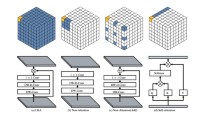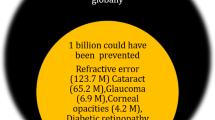Abstract
Eye diseases often affect human health. Accurate detection of the optic disc contour is one of the important steps in diagnosing and treating eye diseases. However, the structure of fundus images is complex, and the optic disc region is often disturbed by blood vessels. Considering that the optic disc is usually a saliency region in fundus images, we propose a weakly-supervised optic disc detection method based on the fully convolution neural network (FCN) combined with the weighted low-rank matrix recovery model (WLRR). Firstly, we extract the low-level features of the fundus image and cluster the pixels using the Simple Linear Iterative Clustering (SLIC) algorithm to generate the feature matrix. Secondly, the top-down semantic prior information provided by FCN and bottom-up background prior information of the optic disc region are used to jointly construct the prior information weighting matrix, which more accurately guides the decomposition of the feature matrix into a sparse matrix representing the optic disc and a low-rank matrix representing the background. Experimental results on the DRISHTI-GS dataset and IDRiD dataset show that our method can segment the optic disc region accurately, and its performance is better than existing weakly-supervised optic disc segmentation methods.
Graphical abstract
Graphical abstract of optic disc segmentation










Similar content being viewed by others
References
Achanta R, Shaji A, Smith K et al (2012) Slic superpixels compared to state-of-the-art superpixel methods. IEEE Trans Pattern Anal Mach Intell 34(11):2274–2282
Almazroa A, Burman R, Raahemifar K et al (2015) Optic disc and optic cup segmentation methodologies for glaucoma image detection: a survey. J Ophthalmol 2015. https://doi.org/10.1155/2015/180972
Aquino A, Gegúndez-Arias ME, Marín D (2010) Detecting the optic disc boundary in digital fundus images using morphological, edge detection, and feature extraction techniques. IEEE Trans Med Imaging 29(11):1860–1869
Babu TG, Shenbagadevi S (2011) Automatic detection of glaucoma using fundus image. Eur J Sci Res 59(1):22–32
Candès EJ, Li X, Ma Y et al (2011) Robust principal component analysis? https://doi.org/10.1145/1970392.1970395
Chang KY, Liu TL, Chen HT et al (2011) Fusing generic objectness and visual saliency for salient object detection. In: 2011 International Conference on Computer Vision, IEEE, pp 914–921
Cheng J, Yin F, Wong DWK et al (2015) Sparse dissimilarity-constrained coding for glaucoma screening. IEEE Trans Biomed Eng 62(5):1395–1403
Cheng MM, Mitra NJ, Huang X et al (2015) Global contrast based salient region detection. IEEE Trans Pattern Anal Mach Intell 37:569–582. https://doi.org/10.1109/TPAMI.2014.2345401
Fu H, Cheng J, Xu Y et al (2018) Joint optic disc and cup segmentation based on multi-label deep network and polar transformation. IEEE Trans Med Imaging 37(7):1597–1605
Gao Y, Yu X, Wu C et al (2019) Accurate and efficient segmentation of optic disc and optic cup in retinal images integrating multi-view information. IEEE Access 7:148,183–148,197
Goferman S, Zelnik-Manor L, Tal A (2012) Context-aware saliency detection. IEEE Trans Pattern Anal Mach Intell 34:1915–1926. https://doi.org/10.1109/TPAMI.2011.272
Haleem MS, Han L, van Hemert J et al (2013) Automatic extraction of retinal features from colour retinal images for glaucoma diagnosis: a review. Comput Med Imaging and Graph 37(7):581-596
Hou X, Harel J, Koch C (2012) Image signature: highlighting sparse salient regions. IEEE Trans Pattern Anal Mach Intell 34:194–201. https://doi.org/10.1109/TPAMI.2011.146
Juneja M, Singh S, Agarwal N et al (2020a) Automated detection of glaucoma using deep learning convolution network (g-net). Multimed Tools Appl 79(21):15,531–15,553
Juneja M, Singh S, Agarwal N et al (2020b) Automated detection of glaucoma using deep learning convolution network (g-net). Multimed Tools Appl 79. https://doi.org/10.1007/s11042-019-7460-4
Lalonde M, Beaulieu M, Gagnon L (2001) Fast and robust optic disc detection using pyramidal decomposition and hausdorff-based template matching. IEEE Trans Med Imaging 20(11):1193-1200
Lee S, Brady M (1991) Optic disk boundary detection. In: BMVC91. Springer, p 359–362
Li H, Chutatape O (2003) Boundary detection of optic disk by a modified asm method. Pattern Recognit 36(9):2093-2104
Lim G, Cheng Y, Hsu W et al (2015) Integrated optic disc and cup segmentation with deep learning. In: 2015 IEEE 27th International Conference on Tools with Artificial Intelligence (ICTAI), IEEE, pp 162–169
Lin Z, Liu R, Su Z (2011) Linearized alternating direction method with adaptive penalty for low-rank representation. Advances in neural information processing systems 24
Long J, Shelhamer E, Darrell T (2015) Fully convolutional networks for semantic segmentation. In: Proceedings of the IEEE conference on computer vision and pattern recognition, pp 3431–3440
Margolin R, Tal A, Zelnik-Manor L (2013) What makes a patch distinct? pp 1139–1146, https://doi.org/10.1109/CVPR.2013.151
Mithun NC, Das S, Fattah SA (2014) Automated detection of optic disc and blood vessel in retinal image using morphological, edge detection and feature extraction technique. 16th Int’l Conf. Computer and Information Technology, IEEE, pp 98–102
Mittapalli PS, Kande GB (2016) Segmentation of optic disk and optic cup from digital fundus images for the assessment of glaucoma. Biomed Signal Process Control 24:34–46
Mohamed NA, Zulkifley MA, Zaki WMDW et al (2019) An automated glaucoma screening system using cup-to-disc ratio via simple linear iterative clustering superpixel approach. Biomed Signal Process Control 53(101):454
Niemeijer M, Abràmoff MD, Van Ginneken B (2009) Fast detection of the optic disc and fovea in color fundus photographs. Med Image Anal 13(6):859–870
Niu D, Xu P, Wan C et al (2017) Automatic localization of optic disc based on deep learning in fundus images. In: 2017 IEEE 2nd international conference on signal and image processing (ICSIP), IEEE, pp 208–212
Pang Y, Wu H, Wu C (2023) Cross-modal co-feedback cellular automata for rgb-t saliency detection. Pattern Recognit 135(109):138
Perez CA, Schulz DA, Aravena CM et al (2013) A new method for online retinal optic-disc detection based on cascade classifiers. In: 2013 IEEE International Conference on Systems, Man, and Cybernetics, IEEE, pp 4300–4304
Porwal P, Pachade S, Kamble R et al (2018) Indian diabetic retinopathy image dataset (idrid): a database for diabetic retinopathy screening research. Data 3(3):25
Reza AW, Eswaran C, Hati S (2009) Automatic tracing of optic disc and exudates from color fundus images using fixed and variable thresholds. J Med Syst 33(1):73–80
Scharfenberger C, Wong A, Fergani K et al (2013) Statistical textural distinctiveness for salient region detection in natural images. pp 979–986, https://doi.org/10.1109/CVPR.2013.131
Sevastopolsky A (2017) Optic disc and cup segmentation methods for glaucoma detection with modification of u-net convolutional neural network. Pattern Recognit Image Anal 27(3):618–624
Shen X, Wu Y (2012) A unified approach to salient object detection via low rank matrix recovery. In: 2012 IEEE Conference on Computer Vision and Pattern Recognition, IEEE, pp 853–860
Simoncelli E, Freeman W (1995) The steerable pyramid: a flexible architecture for multi-scale derivative computation. In: Proceedings., International Conference on Image Processing, pp 444–447 vol.3, https://doi.org/10.1109/ICIP.1995.537667
Sivaswamy J, Krishnadas S, Joshi GD et al (2014) Drishti-gs: retinal image dataset for optic nerve head (onh) segmentation. In: 2014 IEEE 11th international symposium on biomedical imaging (ISBI), IEEE, pp 53–56
Sánchez CI, Niemeijer M, Dumitrescu AV et al (2011) Evaluation of a computer-aided diagnosis system for diabetic retinopathy screening on public data. Invest Ophthalmol Vis Sci 52:4866–4871. https://doi.org/10.1167/iovs.10-6633
Tang C, Wang P, Zhang C et al (2016) Salient object detection via weighted low rank matrix recovery. IEEE Signal Process Lett 24(4):490–494
Wang J, Xia B (2021) Bounding box tightness prior for weakly supervised image segmentation. In: International Conference on Medical Image Computing and Computer-Assisted Intervention, Springer, pp 526–536
Wang L, Liu H, Lu Y et al (2019) A coarse-to-fine deep learning framework for optic disc segmentation in fundus images. Biomed Signal Process Control 51:82–89
Welfer D, Scharcanski J, Kitamura CM et al (2010) Segmentation of the optic disk in color eye fundus images using an adaptive morphological approach. Comput Biol Med 40(2):124–137
Xiong H, Liu S, Sharan RV et al (2022) Weak label based bayesian u-net for optic disc segmentation in fundus images. Artif Intell Med 126(102):261
Yan J, Zhu M, Liu H et al (2010) Visual saliency detection via sparsity pursuit. IEEE Signal Process Lett 17:739–742. https://doi.org/10.1109/LSP.2010.2053200
Yan Q, Xu L, Shi J et al (2013) Hierarchical saliency detection. pp 1155–1162, https://doi.org/10.1109/CVPR.2013.153
Yin F, Liu J, Ong SH et al (2011) Model-based optic nerve head segmentation on retinal fundus images. In: 2011 Annual International Conference of the IEEE Engineering in Medicine and Biology Society, IEEE, pp 2626–2629
Zeevi YY, Zibulski M, Porat M (1998) Gabor analysis and algorithms. Gabor analysis and algorithms
Zhou H, Schaefer G, Liu T et al (2010) Segmentation of optic disc in retinal images using an improved gradient vector flow algorithm. Multimed Tools Appl 49(3):447–462
Zilly J, Buhmann JM, Mahapatra D (2017) Glaucoma detection using entropy sampling and ensemble learning for automatic optic cup and disc segmentation. Comput Med Imaging Graph 55:28–41
Zou B, Liu Q, Yue K et al (2019) Saliency-based segmentation of optic disc in retinal images. Chin J Electron 28(1):71–75
Zou W, Kpalma K, Liu Z et al (2013) Segmentation driven low-rank matrix recovery for saliency detection. In: 24th British machine vision conference (BMVC), pp 1–13
Funding
This work was supported in part by the National Natural Science Foundation of China under Grant nos. U20A20197, 61973063, Liaoning Key Research and Development Project 2020JH2/10100040, Natural Science Foundation of Liaoning Province 2021-KF-12-01 and the Foundation of National Key Laboratory OEIP-O-202005.
Author information
Authors and Affiliations
Corresponding author
Ethics declarations
Conflict of interest
The authors declare no competing interests.
Additional information
Publisher's Note
Springer Nature remains neutral with regard to jurisdictional claims in published maps and institutional affiliations.
Xiaosheng Yu and Chengdong Wu contributed equally to this work.
Rights and permissions
Springer Nature or its licensor (e.g. a society or other partner) holds exclusive rights to this article under a publishing agreement with the author(s) or other rightsholder(s); author self-archiving of the accepted manuscript version of this article is solely governed by the terms of such publishing agreement and applicable law.
About this article
Cite this article
Wang, S., Yu, X., Jia, W. et al. Optic disc detection based on fully convolutional network and weighted matrix recovery model. Med Biol Eng Comput 61, 3319–3333 (2023). https://doi.org/10.1007/s11517-023-02891-2
Received:
Accepted:
Published:
Issue Date:
DOI: https://doi.org/10.1007/s11517-023-02891-2




